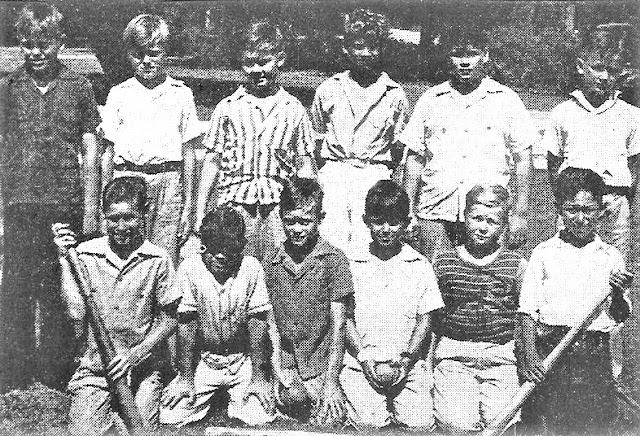.jpg) |
| Rene Torres |
With no uniforms, no score board, no fences and with no cries from parents as none were in sight,the game was a game.
There were no white lines marking the diamond, but rather old running paths established by the generation of players that came before.
The ward school softball competition was a serious proposition with kids playing for city bragging rights.
While Little League baseball in Brownsville did not emerge until the early 1950s—elementary soft-shoe softball and youth playground ball were popular choices for kids back then.
Although football was also part of the elementary curriculum —softball at West Brownsville was a spring sport that dominated all available space on the playground.
Jimmy Pace, who played the hot corner for the Westside boys said then:
“We didn’t use gloves, maybe just the catcher and it was not by choice—as these were tough (financial) times.”
Playing fields at West Brownsville were plenty as back then buildings did not swallow the landscape.
From first grade to the fifth grade, each grade level owned their piece of the perfect diamond.
As the first graders moved through the seasons and bloomed with every play, their goal was to make it with the big squad, the major leagues or the fifth-grade team that participated in formal league against other city ward schools.
All games were played during school hours so there was always a healthy crowd to support the home team.
It was common for kids, teachers and staff to line the foul lines.
Joe Huerta, a former ball player himself, and the school’s custodian, would lay his broom aside and take a break from his regular routine to call balls and strikes.
Mrs. Russell was a “natural” in the classroom and a coach that led her team through a season of brilliant victories.
Her college transcript did not show that she had matriculated in baseball 101, but she was a person of strong character and a disciplinarian that got things done on and off the field.
She was Casey Stengel of elementary coaches.
If you stepped out-of-line, she was a master at using the “board of education,” a piece of an old water hose, recalled one of her students, that measured precisely 3 feet.
It was a tool she did not have to use that often, but when she did, it was with much compassion to deliver a good old-fashioned spanking.
Under her tutelage,the boys finished the elementary softball competition undefeated and untied, trouncing their archrivals from Victoria Heights twice and doing the same to the boys from First Ward School (now, Skinner Elementary).
Every team has a big stick, that kid that could hit the ball consistently and for the Westside boys, it was John Clough, who also had a big chest, at shortstop.
He had sure hands like Phil Rizzuto of the Yankees, but, unlike Phil, he did it barefooted and without a glove.
Marshall Alford, without a doubt, was the best all-around athlete on the team.
He could throw the softball just as he did a football, with accuracy and for long distances.
Marshall went on to establish himself as a star football player with the Brownsville Eagles and Baylor Bears.
Every season must come to an end and, for the softball boys of the Westside, it meant graduating from the sixth grade and closing the curtain to a competitive league.
West Brownsville kids would have to transfer to Clearwater Elementary to attend sixth grade.
The crack of the bat and the sounds and sights of softball were left behind as that school did not field a formal team.
Note: One former team member, who is no longer with us, was interviewed for this story and when asked why there were no Latinos on the team, responded:
“School officials expected all kids to speak English by the time they got to the fourth grade, but, unfortunately, a great majority of them failed to do so, causing them to prematurely drop out of school before they got to the fifth grade to try out for the team.”
Soon after leaving school, many of the kids that left school were seen on the fields doing stoop labor, leaving behind the dreams of playing America’s game.
See you at the park!
Photo: Front row, L to R: John B. White, outfielder; Billy Dorris, catcher; Wayne Cooper, outfielder; Russell Harwood, outfielder; Malcolm Graham, second base and John Clough, shortstop.
Back Row, L to R: Marshall Alford, outfielder; Junior Dumal, pitcher; Melvin Stovall, outfielder; Walter Fortune, outfielder; Freddie Schmidt, first base; and Jimmy Pace, third base.
Not shown: Mrs. Russell, principal and the coach of the team.



.png)

Rene your a class act, great story.
ReplyDeleteAs always, another great article written by my favorite sports historian. On behalf of myself and West Brownsville Little League, thank you, Rene for enriching our present days by sharing stories of our past.
ReplyDeleteBefore your days are done, I sure wish you would compile all of your stories on RGV sports history and publish the book so that your knowledge about our past can live on.
I second the idea of the book. If the book is not written, all these good memories will cease to exist. So many people know information about Brownsville and they do not write the storiesdown. The families are busy...no time to record the stories.
ReplyDelete